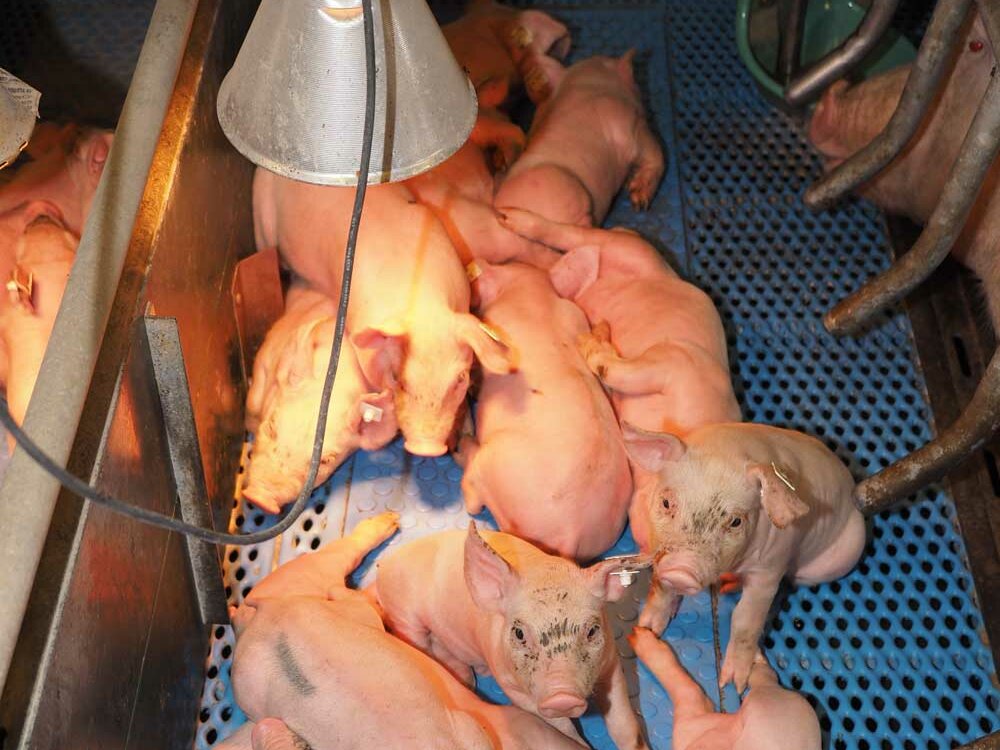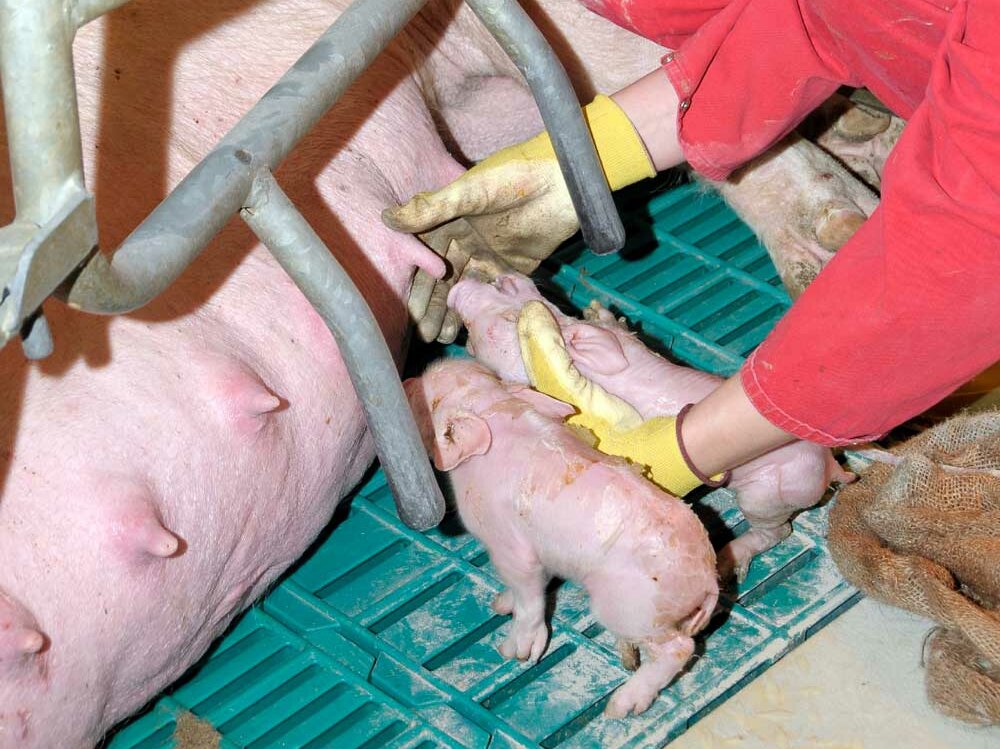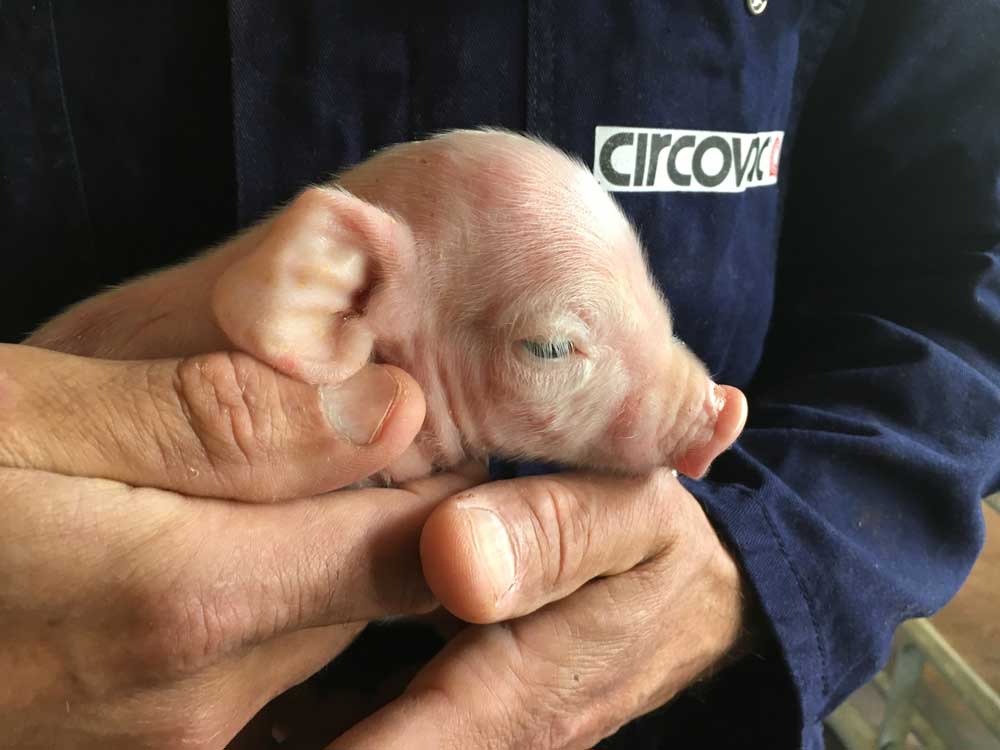Piglet production: The downside of large litters
By Dr Franziska Rink, Biomin Deutschland, and André van Lankveld, Biomin Regional Manager Westeuropa
Over many years the main aim in modern pig genetics was apparently improving sow performance through breeding for more liveborn piglets per litter. At first glance this appears very plausible. However, in practical terms the strategy presents a number of problems – both direct and indirect. There are common limiting constraints applying here, although of course no pig breeding enterprise is exactly the same and there are other possible limiting factors to consider. Basically, though, more liveborn piglets mean less space for each piglet, a reduced weaning weight, a longer farrowing periods as well as higher demands on time and labour.
Less space per piglet
Its seems more than obvious that more young animals born increases requirement for adequate room in a situation where space for each litter is a fixed value in existing buildings. Various trials confirm that reduced space for the youngsters means an automatic increase in mortality through crushing, hypothermia and less colostrum ingestion. Such a »space problem« is then often continued into the rearing accommodation, especially in older building designs simply not sufficiently dimensioned for larger numbers of piglets.
This lack of space is already a problem in the uterus and so the struggle for nutrients begins even before birth. The result: alongside overall reduction in birthweight comes increasing incidence of IUGR (intrauterine growth retardation) piglets. Then the larger the litter, the lighter are the three smallest piglets.

Photo: agrar-press
Reduced weaning weight
Liveweight distribution for litter members is similar for both large and small litters (Gaussian Curve) with proportions of smaller and larger piglets always deviating from the mean. The aim should always be as uniform as possible litters so that piglet size differences are not too pronounced. However, because total litter weight is limited, large litters unavoidably feature smaller piglets. In trials it is clearly demonstrated that from a litter of eleven piglets upwards, the weight of the three smallest members decreases significantly. Should the bodyweight of such piglets sink below the critical value of 900 g, their survival chance is less than 50%. Many studies are devoted to the fact that a poor start in piglet life can never be compensated for right through to the end of feeding. Tendentially, piglets with lower birthweights also subsequently have poorer liveweight gain and feed conversion, both factors prolonging the growing and feeding periods. And here too, the increased requirement for space and feed remains a feature. Taken altogether, these effects result in reduced carcase lean meat proportion, negatively affecting payments from the slaughterhouse. Compared with piglets of normal liveweight, the more expensive growing and feeding costs of the smaller piglets means no positive financial balance can be achieved from them on many farms.

Photo: agrar-press
Prolonged farrowing
This is another factor that sounds straightforward enough at first. The more piglets that pass along the birth canal, the longer farrowing takes. But results in such cases are, in fact, more complex. For instance, a prolonged farrowing can be highly stressful for the sow metabolism so that complications, stillborn piglets and negative effects on the subsequent lactation all increase in proportion to the length of time spent farrowing.
And this applies in a similar way to the piglets involved. The longer the farrowing, the more pronounced are the negative effects. A trial in Canada indicted impressively that survival rate of such piglets could not be improved by direct application of heat. On the other hand, their death rate was able to be reduced through application of oxygen via respirator. This implies serious oxygen deprivation during the longer farrowing procedure, a situation also known in human medicine. Thus, extended farrowing negatively influences the vital functions of the piglets and of the sow.
Additionally, observations indicate that the 115-day gestation period is prolonged (without farrowing induction) towards 117 days where sows are bred to bear larger litters. Here, farrowing induction measures should be kept to a minimum and discussed in detail with the vet. Especially with smaller piglets, every further day in the uterus improves chances of survival. Although prolonging gestation is also not easily achieved under standard systems and work routines.
Higher time and labour input
An oft-heard truism is: »The 10 % smallest piglets require 50 % of the labour input«. This is another observation that depends on each individual farm and its resources. The smaller, weaker, piglets demand considerable investment in effort, especially during the first days of life. The management involved around birth and colostrum uptake is time intensive, but indispensable. With larger litters, feed supplementation has to be often carried out, or fostering (systems) will be necessary.
Through the prolonged suckling period of these piglets, space requirement increases. The added inputs are also expensive. It’s obvious that in this respect best of all for the piglet is, and will always be, the sow’s milk. For this reason, the aim should always be to support the milk production capabilities of the sow. This not only saves money but also labour input and improves piglet vitality.
Especially the smaller piglets need a perfect start in their first hours of life. Directly following birth, the intake of best quality colostrum in sufficient amounts must be ensured. This means the sow must produce her milk »right on time« so that all piglets in a large litter can be supplied with enough colostrum. This requires profound changes in sow metabolism starting in the final days before the birth. At this time the metabolism in the sow’s liver undertakes a radical inversion. Whereas during gestation the liver’s aim is to build-up reserves, from now on the important thing is to mobilise these reserves, making them available for milk production. Just how quickly negative influences on the liver can influence milk production can be understood by seeing the number of tasks required from this organ:
- hormone metabolism,
- vitamin storage,
- blood reservoir function,
- fat digestion,
- detoxification,
- energy metabolism,
- protein/fat metabolism.
Only a healthy sow with a healthy liver can handle such tasks without problems and supply their piglets with sufficient milk.
How is the sow best supported?
On many farms, farrowing preparation feed is offered at the appropriate phase, a feed designed to ease the transition for the sow. Some nutrients and feed additives can additionally support the liver through stimulating the citric acid cycle with the help of certain B vitamins, selected plant extracts and specific stimulating substances.
According to the prevailing situation, such substances can be mixed into the lactation feed, transition rations, or even the gestation feed, for optimal sow support. A better milking performance can be identified either through higher weaning weight for the entire litter or increases in the number of surviving/weaned piglets.
Outlook
Very many factors play a role in the management of large litters. And also not to be forgotten is that any ensuing higher mortality nowadays engenders ever-increasing disapproval, not only from piglet producers themselves, but just as much from consumers. Over the long term, this situation can only be mastered through changing the aims of breeding strategies. In the shorter term, the challenges must be dealt with within the breeding herds themselves. Not every farm is in the position to satisfy the requirements for increased labour input and more space within housing associated with smaller piglets in such litters. On the other hand, from a purely economic perspective, one cannot afford a bad start in life for the smaller piglets in that the first weeks have a direct effect on the entire rearing and feeding performance.
Supplementary feeding pays – especially for small piglets
Particularly smaller piglets often have difficulties maintaining a suckling place at the sow’s udder so that they can ingest sufficient milk. This inequal nutrient supply means the gap between heaviest and lighter piglets continues to widen, a gap which can, however, be reduced through supplementary feeding. However, extra time must be planned into the routine here for optimally adjusted supplementary feeding of the smaller piglets. Offered must be tasty and highly digestible milk and prestarter rations so that a good feed intake is ensured. In this way, higher weaning weights can be achieved as well as better feed intake. This increased feed intake also continues after weaning and results in improved weight gains over the total weaning period. An additional effect is seen in the health of these animals. Thus, through supplementary feeding of large litters a better uniformity can be achieved as well as improved »lifetime performance« in that the advantages continue right through the rearing and feeding phases.
Results of piglet growth retardation (IUGR)
In large litters piglets there is increasing incidence of intrauterine growth retardation (IUGR) piglets. Hereby occurs piglet underdevelopment during gestation through insufficient supply of nutrients. Seen as a cause of this is the poor development, or constriction, of supply vessels often the result of lack of room in the uterus for the large litters developing there. Uterus space is limited, even in very fertile sows with over 14 liveborn piglets per litter. The result is that up to 30% of the piglets in a large litter can be affected by IUGR. Alongside their limited body size, these piglets are recognisable through their steep, dolphin-like forehead, bulging eyes and scraggy hair growth. Altered muscular morphology is also associated with IUGR. Along with high mortality, these piglets have poor daily weight gain and feed conversion performances. The sum of these effects and the retarded growth performance result in a reduction of lean meat in the carcase and, finally, to a negative cost balance over the entire lifetime performance.

Photo: Dr Kees Scheepens


